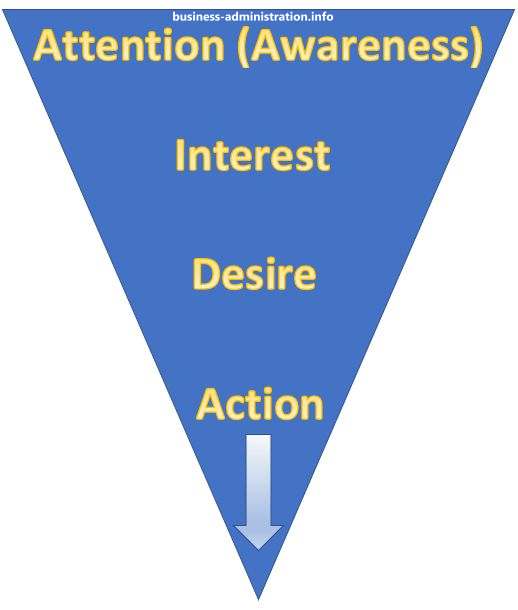The marketing funnel is a model that visualizes the customer journey from the first contact with a potential customer to the purchase. The model visualizes the process by which a company converts prospects into customers and, ideally, retains them long-term. The funnel model is a fundamental part of explanatory sales and is universally applicable.
Online marketing is not an isolated, but rather a separate area. Conventional product marketing, such as television advertising, only includes the third phase: creating demand. It's therefore not surprising that tricks, deception, and pressure are often used, especially in online marketing. For example, stock report sellers often suggest that the report they're about to purchase is official and will only be available for a few days. This is an absolute call to action.
Marketing funnel model
 The funnel model consists of four main phases and forms one of the fundamental schemas of marketing. The well-known "AIDA principle" is used. Anyone who stops at a product in the supermarket, examines it with interest, and decides to put it in their shopping cart has already experienced the main phases. Perhaps at this moment, they are not aware that they are reaping the benefits of the marketing industry's work. This is also because individual needs play a significant role in this experience, and these phases do not occur quickly. If the mobile phone bill is too expensive and another provider is needed, this already represents an access criterion. Whether a web service offers comprehensive price comparisons, the offers on TV commercials seem individually relevant, the market results of a Google search, or a recommendation from a friend captures attention, this form of economics is of enormous importance in the ever-expanding provider market. It is a principle of advertising effectiveness.
The funnel model consists of four main phases and forms one of the fundamental schemas of marketing. The well-known "AIDA principle" is used. Anyone who stops at a product in the supermarket, examines it with interest, and decides to put it in their shopping cart has already experienced the main phases. Perhaps at this moment, they are not aware that they are reaping the benefits of the marketing industry's work. This is also because individual needs play a significant role in this experience, and these phases do not occur quickly. If the mobile phone bill is too expensive and another provider is needed, this already represents an access criterion. Whether a web service offers comprehensive price comparisons, the offers on TV commercials seem individually relevant, the market results of a Google search, or a recommendation from a friend captures attention, this form of economics is of enormous importance in the ever-expanding provider market. It is a principle of advertising effectiveness.
 Attention (Awareness):
Attention (Awareness):
Products or services capture your attention, or an individual problem requires a product solution. In this phase, an existing market offering reaches your awareness.
Interest:
In this phase, you are interested in a product or service. You engage with it, weigh things up, and analyze. You are no longer a visitor; your behavior has undergone a conversion. You are now a prospective buyer.
Desire:
In this phase, you already harbor a desire to purchase. This phase is also called need arousal. You are once again in a state of change.
Action:
In the final phase, an action is triggered. You buy or order a product/service. The purchase desire has taken effect.
In the main phases mentioned, it doesn't matter whether a product or service is paid for. Even taking a free print copy or subscribing to a newsletter constitutes an action. Furthermore, these four main phases and the basic model can be expanded with additional phases, such as a retention phase. This phase aims to retain the customer (or prospective customer) and convert them into a returning or regular customer. A company also benefits from an Advocacy phase, in which prospective customers serve as proponent for a brand, product, or service.
The basic model plays a key role in marketing. Its phase analysis helps companies target and optimize their marketing initiatives to increase the conversion rate. Success makes a sales model measurable and thus scalable. The study of how a product/service develops from initial contact with it to the individual purchase is a perpetual, ongoing research effort in professional marketing. The primary focus of analytical sales is the transformation process: the reasons for the individual's change in attitude toward a product or service. This includes: what exactly is decisive for a purchase and what triggers a change in interest in a simple participant or visitor.
The transformation process is linked to a request for consumer action, the call-to-action (CTA). This action, which can also simply consist of clicking an online button, often completes a change in an individual's status. Almost everyone has been on a social media channel at some point. Here, the CTA is usually followed by the "Subscribe to Channel" button or the influencer with the "Follow" button.
As already mentioned, these principles apply universally. It doesn't matter who or what is being marketed.
The transformation process (marketing conversion)
From the company's perspective, this transformation fundamentally refers to the visitor status and the transition to a new status. This transformation is usually linked to a consumer action. It applies equally to a visit to a supermarket as to a visit to a commercial website. The transformation process also describes the success that is characterized by a visitor's positive action for the company. As a whole, the model can reflect a "full conversion" (vertical funnel conversion) from visitor to paying customer. Within the model, it describes a phase-specific transformation. A transformation from visitor to subscriber to a free offer (including brochures, electronic feeds, or newsletters) already represents a sales success. It is supplemented by a consumer action that is positive for the company, even if the desired payment is missing. The transformation from a simple visitor to a prospective customer thus also represents a small success of the strategy. The associated action can also be a return visit; to the homepage or the store. This is a sales success.
Examples of a marketing conversion:
The purchase of a product. Also ordering a free product: signing up for the newsletter system, ordering a document, or a free product sample. This also includes obtaining (downloading) product brochures, manuals, and other documents. Filling out a contact form or registering in a forum. Registering and using the Payback app.
Here, too, marketing metrics are used to evaluate how many contacts converted or took action. This is known as the "conversion rate." Each of the above-mentioned phases can be viewed and evaluated in isolation.
---
Kotler, Philip/Schellhase, Ralf: Grundlagen des Marketing. Verlag Pearson Studium, 2011.
Lammenett, Erwin: Praxiswissen Online-Marketing. Springer Fachmedien Verlag, 2019.
